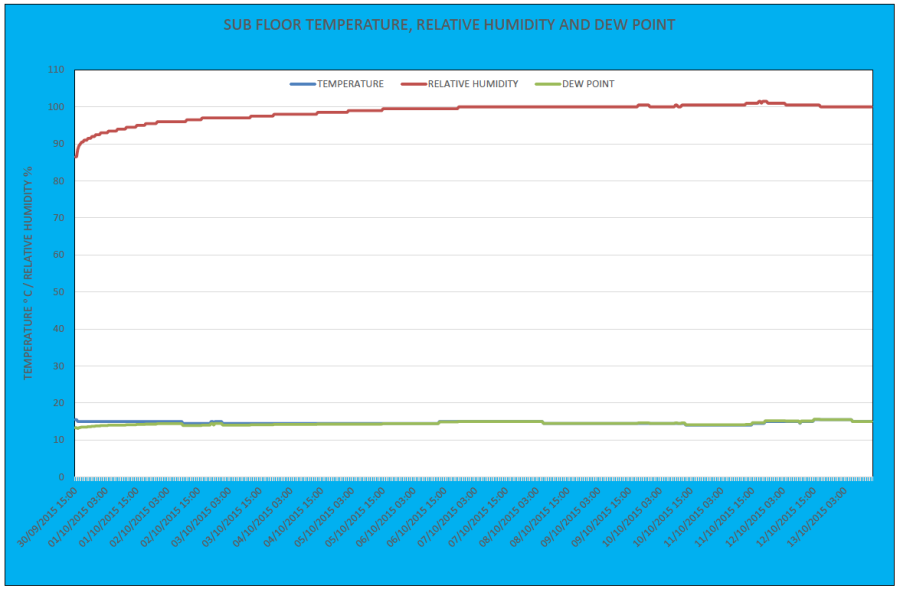Suspended timber floors are very difficult to survey on a pre purchase survey if the surveyor isn’t able to lift any floorboards to inspect the sub floor. Lots of properties now have laminate floor coverings or vinyl floors stuck down in kitchens, or even tiled, which no vendor would wish to lift to faciliate a full sub floor investigation.
Most surveys the surveyor will often do a bounce test to the floors where they will jump on the floor to feel how firm it is under the foot, if the floor is carpeted it maybe possible to stick a damp meter into the timber and measure the moisture content of the timber, and look at the levels of the floors to see if the floor has dropped in places etc.
A surveyor will also see how many, and the location of air bricks, and also note ventilation pathways, for example if the property is a middle terrace with a living room and dining room followed by a new build kitchen at the rear incorporating a solid floor, this would be restricting cross flow ventilation pathways if there is no ducting present through the new solid floor. It is common for builders not to incorporate ducting from the timber suspended floor through the new solid floor to ventilate out. See diagram below.
So what can you do to take the survey a step further?
A hammer probe can be used to check the moisture content of the surface of the timber through a carpet and also through into the timber joist. A good place to check to find a loose floorboard to lift is the under stairs cupboard or a built in cupboard typically by the fireplaces. It maybe possible to drill a small hole in a floor board and view the floor with a high powered boroscope. Sometimes it is possible to remove an air brick and insert a snake camera system, we can also photograph the defects for the report.

We also use where a possible a remote control car that has lighting a a video camera installed that can reach hard to access areas.
In an ideal world many of the floorboards would be lifted so you can actually visually check the floorboards, joists and plates. Cellar fungus decay typically leaves a thin surface veneer, and it’s not until you drive a bradawl into the timber you notice how significant the decay actually is.
Why is ventilation important?
Ventilation is paramount to prevent decay and woodworm infestation, fungal decay and woodworm need moisture to survive, without this they will not survive. Timber is naturally hygroscopic, this means it will absorb moisture from the surrounding air. Suspended timber floors are cold places, with cold temperatures subsequently there will be high relative humidity readings. Older historic properties are more likely to have a hardwood flooring timbers, this is less prone to decay and infestation unlike modern fast grown softwood. Most of the really active woodworm infestations I find are where the floor is a softwood, some of these floors have been dangerous and have collapsed.
The below picture shows a severe active woodworm infestation, this was in a property in Trowbridge Wiltshire.
The fungal decay is a dry rot, this is from the sub floor which consisted of new pre treated timber, the ends of the timber were not treated hence thats where it appears the rot has started. This dry rot was in a suspended timber floor in Wiltshire.
There are a few Property Care Association surveyors that have been collecting data from sub floors to see what is actually happening, collecting data using data loggers is a relatively simple exercise that helps in the diagnosis and understanding of fungal decay and woodworm problems.
See the graph below that we produce in excel, we also use this data logging for the internal environment typically for condensation and mould surveys. Where the green and the blue line cross shows when condensation is occurring, the floor was virtually suffering from condensation during the whole time it was being monitored.
Sub floor condensation where water droplets are dripping actually off the floorboards isn’t that common or as common as some people suggest. Below is a picture of a sub floor condensation issue, and there is also a significant dry rot issue, this was caused because there was a lack of sub floor ventilation in this property situated in Devizes Wiltshire.
The below picture shows sub floor condensation issue and early signs of wet rot fungal decay in a property in Trowbridge Wiltshire.
The two below graphs show data logging of the sub floor void, this is measuring cross flow ventilation from the from and the back of the house. This is carried out using a calibrated anemometer, looking at the graph you can see how this went up and down because of the wind, even in that short space of time. This showed there was adequate cross flow ventilation in the sub floor void.
Another thing that some people fail to realise is that the suspended timber floor void is also partly controlled by the internal environment, if you have high vapour pressure in the building because of poor mechanical ventilation this will go to low vapour pressure, like the roof void and also the sub floor.
If you need a sub floor survey / camera sub floor survey / investigation for woodworm or dry rot – wet rot please contact us and we would be happy to assist you 01225 769215 www.completepreservation.co.uk
We also offer non destructive dry sub floor surveys using specialist dry rot sniffer dogs, we carry this out with a company called Enviro-Dogs 07764755301









